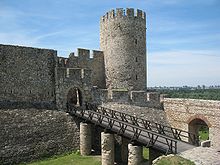Gate of the Despot

The Despot's Gate and the Castellan Tower - often called the East Gate of the Upper Town - were the main entrance to Belgrade Castle during the Middle Ages . Together with the north-east wall, it is the best-preserved segment of the medieval fortifications of the upper town from the first half of the 15th century during the renovation under the Serbian despot Stefan Lazarevic . Only the gate of the despot has been preserved in its original form to this day. It consists of a double wall with two entrances. The inner gate has a defensive balcony - the 'masikula'. Below is a niche for an icon of Our Lady as the protector of the city. Next to the gate is the square Cstellan tower. Its name comes from the fact that the fortress commander had his seat here in the 18th century.
The tower was badly damaged in the 1915 bombing of Belgrade. Partially built in 1938, the battlement weir comes from a renovation in the late 1970s. The Castellan Tower is now home to the Rudjer Boskovic astronomical observatory .
history

The gate of the despot is built as the main gate of the upper town of the fortress of Belgrade on remains of ancient walls. It is firmly secured by a ditch and a double wall and has a suspension bridge.
When the Turkish Sultan Mehmet II besieged the city in 1456 , the decisive battle broke out at the despot's gate. The Turks manage to penetrate through the gate into the upper town where a violent battle breaks out. The Hungarian defenders succeed in pushing back the Turks.
Pictorial representations of the siege of 1456 and the battle at the despot's gate
The battle at the despot's gate is a Turkish miniature of the Hünername , depicted today in the Topkapi Museum in Istanbul. The Church of Our Lady in Olmouc in the Czech Republic also shows the battle at the Despot's Gate.

